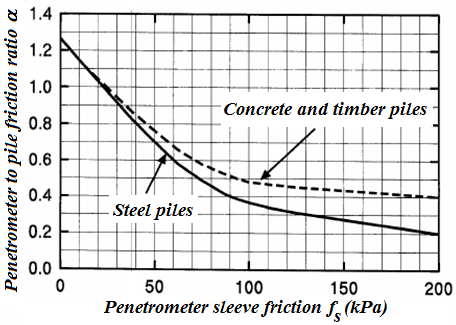Shaft Friction Coefficient ALFAs
The coefficient reducing the shaft friction αs differs based on the applied method and the type of soil. The values of these coefficients are built into the program according to EN 1997-2 and NEN 6743 standards.
The values for sands and sands with gravel are listed in the following table:
Piles | NEN 6743 αs [-] | EN 1997-2 αs [-] |
prefabricated driven piles or steel piles | 0.010 | 0.010 |
Franki piles | 0.014 | 0.012 |
driven wooden piles | 0.012 | 0.012 |
vibrating or vibropressed | 0.012 | 0.012 |
cast in place screw piles | 0.009 | 0.009 |
prefabricated screw piles | 0.009 | 0.009 |
cast in place screw piles with additional grouting | 0.006 | 0.006 |
prefabricated screw piles with additional grouting | 0.006 | 0.006 |
steel tubular piles | 0.0075 | 0.0075 |
Continuous Flight Auger piles (CFA) | 0.006 | 0.006 |
bored piles or piles sheeted by bentonite suspense | 0.006 | 0.006 |
bored piles with steel casing | 0.005 | 0.005 |
For very coarse-grained sands and gravels the above values are reduced in both methods by a reduction coefficient (coarse-grained sand 0.75, gravel 0.5).
For peat the value of αs = 0 is considered.
For clay and silt the values of αs according to the EN 1997-2 are listed in the following table:
Type of soil | qc [MPa] | αs [-] |
clay | > 3 | < 0.030 |
clay | < 3 | < 0.020 |
silt | < 0.025 |
For clay and silt the values of αs according to the NEN 6743 are listed in the following table:
qc [MPa] | αs [-] |
> 1 | 0.035 |
< 1 | 0.0 depth to quintuple of pile diameter |
0.025 depth from 5 to 20 multiple of pile diameter | |
0.035 depth over 20 multiple of pile diameter |
If the LCPC (Bustamante) method is used the shaft friction coefficient αs is used depending on the tip resistance qc (orientation values are available in the following table).
Orientation values of the shaft friction coefficient αs based on the cone tip resistance qc
LCPC (Bustamante) Soil type | Cone stress (tip resistance) qc [MPa] | αs for piles of type "A" | αs for piles of type "B" | Maximum shaft resistance [kPa] |
Clay | < 1 | 0.033 | 0.033 | 15 |
1 < qc < 5 | 0.025 | 0.011 | 35 | |
5 < qc | 0.017 | 0.008 | 35 | |
Sand | qc < 5 | 0.010 | 0.008 | 35 |
5 < qc < 12 | 0.010 | 0.005 | 80 | |
12 < qc | 0.007 | 0.005 | 120 |
Type "A" includes these types of technology of installation of piles:
- screw (cast in place, prefabricated, cast in place with additional grouting, prefabricated with additional grouting, CFA piles, bored or piles sheeted by bentonite suspense)
- driven prefabricated
Type "B" includes these types of technology of installation of piles:
- driven steel
- Franki piles
- vibrating
- steel tubular
- bored with steel casing
When using Schmertmann method, coefficient αs reducing shaft friction according to Tomlinson is considered. Values used in the program are derived from the following graph mentioned in publication M. J. Tomlinson: Pile Design and Construction Practice (1994).

For the NBN EN 1997-1 ABN standard, the coefficients are taken as follows:
Piles | αs [-] | αs,tert. clay [-] |
prefabricated driven piles or steel piles | 0.6 | 0.6 |
Franki piles | 1.0 | 0.9 |
driven wooden piles | 1.15 | 1.15 |
vibrating or vibropressed | 0.6 | 0.6 |
cast in place screw piles | 0.6 | 0.6 |
prefabricated screw piles | 0.6 | 0.6 |
cast in place screw piles with additional grouting | 0.6 | 0.6 |
prefabricated screw piles with additional grouting | 0.6 | 0.6 |
steel tubular piles | 0.6 | 0.6 |
Continuous Flight Auger piles (CFA) | 0.5 | 0.3 |
bored piles or piles sheeted by bentonite suspense | 0.5 | 0.5 |
bored piles with steel casing | 0.5 | 0.3 |
Literature:
Tomlinson M. J.: Pile Design and Construction Practice, 4th edition, Taylor and Francis, 1994, ISBN 0 419 18450 3.
RICHTLIJNEN VOOR DE TOEPASSING VAN DE EUROCODE 7 IN BELGIË VOLGENS DE NBN EN 1997-1 ANB (WTCB Rapport nr. 20 - November 2020)